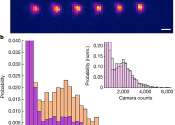Self-assembled nanostructures with atomically precise structure and tailored electronic properties
Bio organisms are the most-complex machines we know, and are capable of achieving demanding functions with great efficiency.

Bio organisms are the most-complex machines we know, and are capable of achieving demanding functions with great efficiency.
Nanomaterials
Aug 13, 2018
0
32

A team of physicists at Harvard University has succeeded in trapping individual polyatomic molecules in optical tweezer arrays for the first time. In their paper published in the journal Nature, the group describes how they ...

Single-molecule electronic devices, which use single molecules or molecular monolayers as their conductive channels, offer a new strategy to resolve the miniaturization and functionalization bottlenecks encountered by traditional ...
Nanomaterials
Jun 2, 2022
0
26

Researchers have spent more than three decades developing and studying miniature biosensors that can identify single molecules. In 5 to 10 years, when such devices may become a staple in doctors' offices, they could detect ...
Bio & Medicine
Apr 27, 2021
0
106

Curtin researchers have developed a tiny electrical circuit that may enable an entirely new design of digital devices.
Nanophysics
Aug 28, 2018
0
54

Two highly similar molecules with essential but often contrasting signaling roles in most life forms exert their distinct effects through subtle differences in their bindings to their signaling partners, according to a new ...
Cell & Microbiology
May 9, 2023
1
223

Researchers from the University of Oxford have constructed a "molecular hopper," capable of moving single strands of DNA through a protein nanotube.
Materials Science
Aug 31, 2018
0
156

An interdisciplinary research team of the Institutes of Physical Chemistry and Physics of the University of Freiburg and the Max Planck Institute of Biophysics in Frankfurt-am-Main has discovered a new, direction-dependent ...
Bio & Medicine
Mar 31, 2023
0
23

Quantum plasmonics is the study of quantum properties of light and its interaction with matter at the nanoscale. While intriguing, they are difficult to regulate on account of the lack of proper surface spaces to reversibly ...

There are cells in the body known as pluripotent stem cells that are yet to specialize in a particular biological function. These cells maintain the potential to become any of the possible cell types in an organism. Pluripotent ...
Cell & Microbiology
Apr 28, 2022
0
12